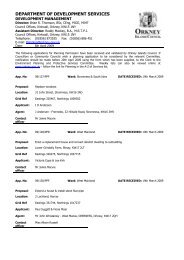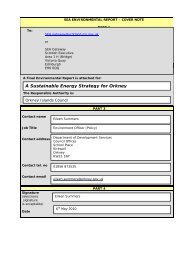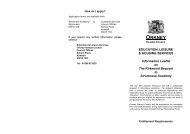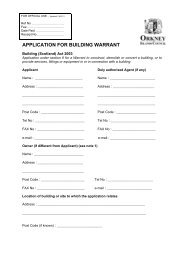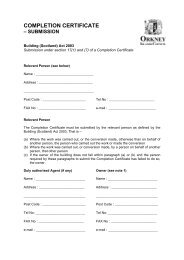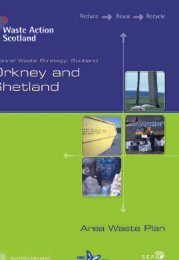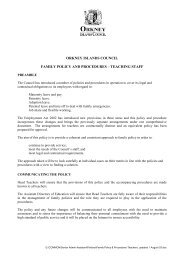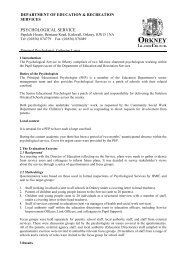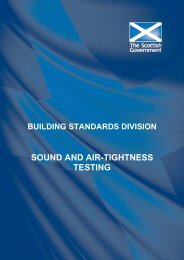SER Technical Bulletin No 1 - Structural Engineers Registration Ltd
SER Technical Bulletin No 1 - Structural Engineers Registration Ltd
SER Technical Bulletin No 1 - Structural Engineers Registration Ltd
Create successful ePaper yourself
Turn your PDF publications into a flip-book with our unique Google optimized e-Paper software.
Scheme For Certification Of Design (Building Structure)<br />
<strong>SER</strong> <strong>Technical</strong> <strong>Bulletin</strong> <strong>No</strong> 1- Revision A<br />
Certification of Contractor Designed Details<br />
Introduction<br />
On many construction projects standard components or details are designed by a<br />
specialist contractor often some time after the general layout design of the structure has<br />
been completed. Typical components which fall into this group are manufactured timber<br />
roof trusses, steelwork connections or piling. Other key structural components may be<br />
chosen on the basis of information presented in manufacturer’s catalogues or test<br />
certification however these may not be specified at the time the warrant application has<br />
been lodged. Precast floor units or anchor fixings fall into this category.<br />
These details can often have a vital role in ensuring the integrity and performance of the<br />
structure and there is no doubt that they fall within the scope of the structural certification<br />
process. Design embraces details necessary to ensure the safety and integrity of the<br />
structure. This is the opinion of the Institution of <strong>Structural</strong> <strong>Engineers</strong> expressed in their<br />
publication Aims of <strong>Structural</strong> Design: August 1969 which states: “Detailing must be seen<br />
as an integral and important part of design; it is a matter of which the designer cannot lose<br />
control”<br />
The nature of the construction process is such that work frequently commences on site<br />
before all of the detailed design has been completed. Building Warrants must be obtained<br />
before work commences and can be a precondition of funding being made available to<br />
enable the award of specialist sub-contracts. The building warrant process and the<br />
associated structural certification process must be sufficiently flexible to accommodate the<br />
realities of construction while still providing the necessary safeguards to public safety.<br />
This <strong>Technical</strong> <strong>Bulletin</strong> is intended to provide Approved Certifiers with options for<br />
discharging their responsibilities for certification while still accommodating the needs of<br />
their clients for flexibility in the design and construction of the building.<br />
Requirements of the Legislation<br />
A building warrant must be granted if the verifier is satisfied that nothing in any plan<br />
specification or other information submitted with the application indicates that the building<br />
when constructed will fail to comply with the regulations. The information to be submitted<br />
with the application is detailed in schedule 2 of the Procedure Regulations and, with regard<br />
to structure, will include general arrangement drawings showing the layout and dimensions<br />
of foundations and structural members.<br />
Verifiers have some discretion regarding the level of detail that they require to accompany<br />
the application and BSD have provided guidance (available at www.scotland.gov.uk/bsd),<br />
in the Procedural Handbook and the supplementary Procedural Guidance on Certification,<br />
regarding the information that is to be submitted with a Building Warrant application when<br />
1
Scheme For Certification Of Design (Building Structure)<br />
the application is accompanied by a certificate from an Approved Certifier of Design. In this<br />
circumstance verifiers are not expected to require design calculations or details of<br />
reinforcement for example but will require sufficient information to undertake site<br />
inspections for construction compliance.<br />
The responsibilities of Certifiers are separately defined by section 11 of the Act. The Act<br />
requires certification of the design of the building and design, as we have seen above,<br />
embraces details which may not be supplied to the verifier at the time that the warrant is<br />
granted. Flexibility is offered to certifiers in section (1) (a) of the Act by the statement<br />
“…..or of such part of it as is specified in the certificate….”. Where structural details are to<br />
be confirmed after a warrant has been granted (even once construction has commenced<br />
on site) it is this provision of the legislation which has allowed the Scheme to offer some<br />
flexibility in the way that certification can be used to provide the information required by the<br />
legislation.<br />
Staged Warrants<br />
Staged Warrants may be used to enable an early site start by restricting the content of the<br />
design included within the early stages solely to the structure. A verifier may grant a<br />
warrant with a condition that information on later stages (which will be listed in the warrant<br />
form) is to be provided later. This will allow such stages, accompanied by the appropriate<br />
certification, to pass quickly through the local authority verification process. A first stage<br />
comprising only piling and sub-structure for example may be lodged as soon as these<br />
elements have been certified and work may commence very quickly thereafter. Care must<br />
be taken however to ensure that only certified structural works are included in the staged<br />
application. If other matters such as drainage have been included in the package then the<br />
warrant will take longer to process.<br />
The Approved Certifier must issue a separate certificate for each stage and this must<br />
relate only to the work included in the particular stage. It is the responsibility of a Certifier<br />
to make sure that a design certified for a particular stage is also consistent with the design<br />
of any previously certified stages. One Certifier will sign all of the certificates submitted for<br />
a particular project (but see the scheme guide for procedure to be followed where this is<br />
not possible).<br />
Work on subsequent stages must not commence until the design of these have been<br />
submitted to the verifier and a staged warrant granted. The client carries a risk that<br />
subsequent changes, perhaps arising out of building regulation compliance issues not<br />
previously identified, could require costly changes to an already constructed stage.<br />
The choice of appropriate stages is a matter for agreement between the applicant and the<br />
local authority verifier. The Procedure Regulations do prescribe stages however this is<br />
limited to the construction of foundations or any other stages as the verifier considers<br />
appropriate having regard to guidance issued by Scottish Ministers. The Approved<br />
Certifier should be prepared to offer advice on this matter to the client.<br />
For a detailed explanation of the staged warrant procedure readers should consult the<br />
relevant sections of the Scheme Guidance issued by <strong>SER</strong> <strong>Ltd</strong> and the procedural<br />
guidance issued by BSD.<br />
2
Scheme For Certification Of Design (Building Structure)<br />
Post Warrant Contractor Designed Details<br />
Stages are not however a universal solution to this problem. While they may be used with<br />
good effect on large projects the use of staged warrants is seldom appropriate to small<br />
domestic works where, for example, the timber roof truss may be the only structural<br />
element provided by a specialist contractor.<br />
On larger projects it may not be possible to separate all of the structural details from other<br />
aspects of the design that are sensibly included within the application or a particular stage.<br />
A superstructure stage may for example be applied for once the main structural frame has<br />
been designed but before the design of the connections has been undertaken.<br />
To accommodate these situations the <strong>SER</strong> scheme includes an option which will permit<br />
the certification of specific details to be undertaken some time after the certification of the<br />
general structural arrangement has been completed and a warrant (or staged warrant) has<br />
been granted by the verifier. The key features of this option are:<br />
• The Certificate must be accompanied by a completed Schedule 1, which lists<br />
any structural items or details that are subject to detailed design by a specialist<br />
supplier or contractor which has yet to be completed.<br />
• The warrant submission must include sufficient information and detail in respect<br />
of the scheduled items. Guidance is provided in the BSD publication “Procedural<br />
Guidance on Certification including information to be submitted with a Building<br />
Warrant Application”. Where this is not possible the elements in question should<br />
be deferred for inclusion in a later, separate staged application.<br />
• The warrant submission must contain a performance specification for any items<br />
or details listed on Schedule 1. This should include the following information:<br />
o The specific design standard(s) to which the item is to be designed eg<br />
reference to a particular Eurocode or British Standard<br />
o The loads for which the item is to be designed or sufficient information to<br />
enable the designer to make an assessment of the loads<br />
o The building risk classification eg 1, 2A, 2B, 3<br />
o Any serviceability criteria eg deflection or vibration limits<br />
o Any durability requirements eg exposure condition<br />
o Any fire performance criteria eg minimum period of fire resistance, where<br />
relevant<br />
o Any special requirements eg minimum or maximum member size; minimum<br />
material specification<br />
o Information that is to be supplied to the certifier eg design calculations;<br />
drawings; materials specification; details of connections to the supporting<br />
structure; details of loads that will be applied to the supporting structure<br />
• The certifier will receive information from the specialist contractor that<br />
demonstrates compliance with the performance specification and compatibility<br />
with the previously certified design once this is available.<br />
3
Scheme For Certification Of Design (Building Structure)<br />
• If the design does not comply with the performance specification but does satisfy<br />
the requirements of the regulations then an application to amend the warrant<br />
must be made.<br />
• A building warrant (including the warrant for a stage), granted by a verifier for an<br />
application accompanied by a certificate described above, will be accompanied<br />
by a notice, Form Q, that is to be returned to the verifier once the certifier is<br />
satisfied regarding the design of the detail.<br />
• Form Q will be signed by the certifier and by the approved body for submission<br />
to the verifier.<br />
• The Verifier will refuse to accept a completion certificate unless Form Q has<br />
been returned.<br />
This procedure should only be used to deal with clearly defined contractor designed<br />
structural details. The design certificate(s) must cover all structural elements that are<br />
shown on the warrant plans.<br />
This procedure is intended for use with specific identifiable building components. It is not<br />
to be used for contractor-designed structural frames, such as steel portal frames or timber<br />
kits, or for other primary elements of structure.<br />
Form Q is a generic form (available at www.scotland.gov.uk/bsd) which will be used by all<br />
verifiers and certifiers in a model format specified by BSD (see the Appendix for the <strong>SER</strong><br />
specific Form Q). ).<br />
4
Scheme For Certification Of Design (Building Structure)<br />
The steps to be followed when applying this option are set out in the following table:<br />
Procedure<br />
<strong>No</strong>te<br />
Step1<br />
Step 2<br />
Step 3<br />
Building Warrant<br />
Application lodged<br />
Verifier issues<br />
Building Warrant<br />
Client appoints<br />
specialist contractor<br />
Certifier issues a design certificate for building or stage<br />
accompanied by Schedule 1 listing details to be<br />
designed later but which are described in the<br />
application by performance specification(s).<br />
The building warrant is accompanied by Form Q :<br />
“<strong>No</strong>tification of Finalisation of <strong>Structural</strong> Details”<br />
Other work included within warrant can commence on<br />
site.<br />
Step 4<br />
Specialist contractor<br />
supplies project<br />
certifier with design<br />
for detail(s)<br />
Certifier checks contractor design for compliance with<br />
performance specification(s) and for consistency with<br />
the overall structural design. Any divergence from this<br />
would require an amendment to Warrant.<br />
Step 5<br />
Project Certifier<br />
approves design and<br />
returns signed Form<br />
Q to the Verifier<br />
<strong>No</strong>tification also needs to be signed by the Approved<br />
Body. Certifiers should retain a copy of the signed<br />
notification and the design information supplied by the<br />
specialist contractor for audit purposes.<br />
Step 6<br />
Client submits<br />
completion certificate<br />
to verifier.<br />
Before accepting a completion certificate from the<br />
applicant the verifier will check that Form Q has been<br />
returned relating to any details previously listed in<br />
Schedule 1 to the design certificate(s)<br />
Revision A, April 2011<br />
5
Scheme For Certification Of Design (Building Structure)<br />
Appendix<br />
MODEL FORM Q<br />
NOTICE OF FINALISATION OF DESIGN DETAILS<br />
Building (Procedure) (Scotland) Regulations 2004<br />
<strong>No</strong>tification of finalisation of design of elements specified in schedules to certificates<br />
issued in accordance with regulations 32 and 34<br />
Part A to be completed by approved certifier<br />
I hereby give notice that the detailed design of the elements specified in the schedule to<br />
the certificate of design number -<br />
relating to building warrant reference number –<br />
has been finalised and is in accordance with the relevant performance specification.<br />
Name of certifier-<br />
<strong>Registration</strong> number of certifier –<br />
Signed -<br />
Dated –<br />
(Certifier)<br />
Part B to be completed by approved body<br />
I confirm that the person signing Part A is an approved certifier of design and is a principal<br />
in or is employed by this body.<br />
Name of approved body –<br />
<strong>Registration</strong> number of approved body –<br />
Signed -<br />
Dated –<br />
(Certification co-ordinator of Approved body)<br />
6






